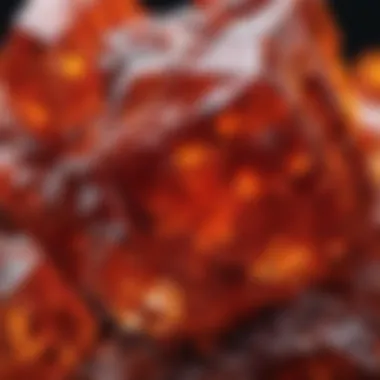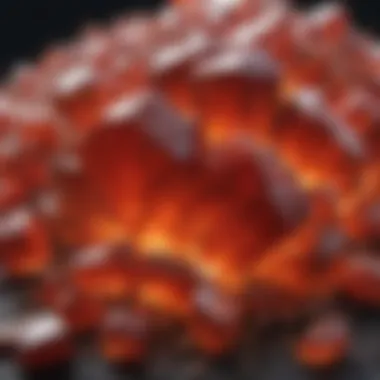An In-Depth Exploration of Vanadinite Crystals


Intro
Vanadinite crystals have long captivated mineralogy enthusiasts and collectors. These striking formations, with their vibrant hues and interesting texture, offer not only aesthetic appeal but also a depth of history and scientific intrigue. Their unique properties and origins make them stand out in the diverse world of minerals. This article delves into the intricacies of vanadinite crystals, presenting a thorough exploration of their formation, identification, care, and ethical considerations, while also shedding light on their various applications across industries.
Featured Collectible of the Month
Overview
Vanadinite (Pb5(VO4)3Cl) is a lead vanadate mineral that typically manifests in hexagonal prisms, often adorned with platy or tabular forms. The colors range from orange to red, brown, and even yellow, driven largely by its chemical composition. Its luster is often described as resinous, which contributes to the overall attractiveness for collectors. Each piece tells a story of its geological journey, making it a notable specimen for any collection.
Historical Significance
The significance of vanadinite extends beyond its physical characteristics. It was first discovered in the 19th century, primarily in the ore deposits of the United States, particularly in Arizona. Beyond its mineralogical appeal, vanadinite holds historical value as it has been used in the extraction of vanadium, a metal important for steel production and other industrial applications. Notably, vanadium's role in metallurgy showcases how a simple mineral can have a profound impact on technology and engineering.
Identification Techniques
Identifying vanadinite requires a keen eye and understanding of its distinct physical characteristics.
Visual Characteristics
- Color: Predominantly red, orange, or brown.
- Luster: Resinous with a slight shimmer.
- Crystal Structure: Typically found in hexagonal crystals, often forming dense clusters.
- Hardness: Ranges from 3 to 4 on the Mohs scale, meaning it is relatively soft and can scratch easily.
- Cleavage: Exhibits perfect cleavage in one direction, making it easier to identify when examining specimens closely.
Resources for Identification
For those new to mineral collection or identification, several resources can aid in distinguishing vanadinite from similar minerals:
- Mindat.org: A comprehensive database of minerals and their properties.
- Wikipedia: Offers basic yet effective summaries on minerals, including vanadinite.
- Local Mineral Shows: Attending shows provides a chance to learn from seasoned collectors and experts.
- Reddit Communities: Forums such as r/mineralcollectors can yield valuable insights from fellow enthusiasts.
"Understanding the nuances of mineral identification can greatly enhance your appreciation and collecting experience."
In summary, vanadinite crystals are not only a treat for the eyes but also hold significant historical and industrial value. With careful observation and a few identification techniques, collectors can appreciate vanadinite not just as a collectible, but as a piece of our geological history.
Prologue to Vanadinite
Understanding vanadinite is vital for those interested in geology and mineralogy. This mineral, primarily composed of lead vanadate, plays a significant role in various industrial applications. The uniqueness of vanadinite lies not only in its chemical structure but also in its vibrant colors and crystal forms.
Its presence in mineral collections also speaks to its aesthetic qualities and historical significance. An exploration of vanadinite offers insights into the earth’s composition and geological processes. Collecting vanadinite becomes more rewarding when enthusiasts have a comprehensive understanding of its classification, properties, and extraction processes. This section aims to lay the groundwork for appreciating vanadinite as both a collectible item and an important mineral.
Defining Vanadinite
Vanadinite is a mineral that primarily consists of lead vanadate, which is represented by the chemical formula Pb5(VO4)3Cl. It normally forms in the oxidation zones of lead deposits where vanadium is present. This mineral exhibits notable features such as tetragonal crystal system, which allows it to form well-defined crystals. Its color can be various shades, but it typically appears in red, orange, yellow, or brown hues.
This mineral has a strong connection to more well-known minerals like vanadinite ore, widely used in the extraction of vanadium. The study of vanadinite can inform collectors about the mineral's environment, including where it is typically found and how it is formed.
Classification and Overview
Classification of vanadinite falls under the category of vanadates. It is included in the broader classification of minerals based on their chemical properties. The mineral is primarily studied for its crystal habit and color variations.
There are several key characteristics to understand about vanadinite:
- Luster: Exhibits a resinous to vitreous luster.
- Transparency: Generally transparent to translucent, enhancing its appeal in collections.
- Hardness: On the Mohs scale, vanadinite ranges from 3 to 4, indicating it is relatively soft compared to other minerals.
Vanadinite can be found in various locations around the world, notably in Morocco, the United States, and Mexico. Collectors usually value specimens based on their size, color saturation, and the quality of the crystal formation.
In summary, understanding these aspects of vanadinite sets the stage for a deeper exploration of its geological formation, physical properties, historical significance, and practical uses in modern industry.
Geological Formation of Vanadinite
The geological formation of vanadinite is essential to understanding its characteristics and significance as a mineral. Vanadinite is a secondary mineral, which means its formation results from the alteration of primary minerals. This process occurs in a specific geological environment and is largely influenced by several factors such as temperature, pressure, and the availability of certain elements. By exploring this aspect, we can gain insights into the conditions that led to the emergence of vanadinite and its role within the ecosystem of minerals.
Mineral Composition
Chemical Structure


Vanadinite’s chemical structure is a key component in defining its unique properties. It has the formula Pb5(VO4)3Cl, which highlights the presence of vanadium in the form of VO4 tetrahedra. This characteristic contributes to the mineral's notable vibrant colors, which range from orange to red. The inclusion of lead in its structure makes it denser than many other minerals.
The complexity of the chemical structure plays a crucial role in its crystallization process. Such distinct arrangements in the crystal lattice can affect how vanadinite interacts with other substances and its behavior under different conditions.
A unique feature of the chemical structure is its stability under certain environmental conditions, allowing it to remain intact for extended periods. This can make it beneficial for collectors seeking minerals that retain their visual appeal over time, even when exposed to various elements.
Common Variants
Common variants of vanadinite can be particularly interesting due to their unique attributes. For instance, some vanadinite crystals might exhibit slight differences in color or clarity, influenced by the amount of lead, vanadium, or other trace elements present during formation.
The key characteristic of these variants is that they can exhibit various shades, making some more desirable to mineral collectors. Collectors often seek out these variants not only for their aesthetic appeal but also for their potential rarity compared to typical vanadinite specimens.
What is especially notable about these common variants is how each may retain a distinct signature that reflects the geological circumstances of its formation, leading to heightened interest within the community.
Formation Environment
Sources of Vanadium
The sources of vanadium play a significant role in the formation of vanadinite crystals. Vanadium is generally derived from various materials, such as igneous rocks or sedimentary deposits. Understanding where vanadium originates provides insight into the broader geological contexts that foster the formation of vanadinite.
A major characteristic of these sources is that they often contain other compounds that can interact with vanadium, creating conditions ripe for vanadinite to develop. This relationship between vanadium and its geological matrix contributes to the complexity of the mineral's formation.
Identifying the sources of vanadium can help geologists and mineral enthusiasts connect it with specific locations, enhancing its collectability and historical importance.
Hydrothermal Processes
Hydrothermal processes are central to the formation of vanadinite, influencing both its chemical properties and crystal morphology. These processes involve hot, mineral-rich fluids circulating through rock formations, depositing minerals as they cool and solidify. This allows for significant mineral diversity.
The key characteristic of hydrothermal processes is temperature variability. The thermal conditions during mineral formation contribute directly to how vanadinite crystals grow and evolve. Hydrothermal settings provide a fertile ground for vanadinite development, often resulting in unique and well-formed specimens.
A unique aspect of hydrothermal processes is their capacity to create localized deposits of minerals, which might lead to exploitation or collection opportunities favorable for rock and mineral collectors. Understanding how these processes work enhances our appreciation for how vanadinite is shaped and its broader role in the mineral kingdom.
Thus, geological formation is crucial for recognizing both the beauty and the complex origins of vanadinite, making it an important subject for both scientific study and mineral collection.
Physical Properties of Vanadinite Crystals
The physical properties of vanadinite crystals are crucial for understanding their formation, identification, and applications. These characteristics define how the mineral interacts with light, how it can be distinguished from other minerals, and its overall durability in various environments. By examining these properties, one can appreciate the unique aspects of vanadinite and its significance in geology and mineralogy.
Crystal Structure
Vanadinite has a distinctive hexagonal crystal structure, often forming tabular or prismatic shapes. This structural arrangement is primarily due to its chemical formula, which is Pb5(VO4)3Cl. The presence of lead, vanadium, and chlorine in the structure contributes to the crystal's stability and gives it notable physical characteristics.
The inner workings of vanadinite's crystal lattice allow it to grow in various environments, influencing its habit. The crystals can appear as elongated, slender shapes or can aggregate into larger clusters. Collectors often seek out vanadinite specimens with well-defined crystals, as these are particularly visually striking and valuable.
Colors and Transparency
Vanadinite crystals are renowned for their striking colors, which can range from bright red to orange, and occasionally to yellow or brown hues. The primary factor influencing the color is the presence of vanadium ions within the crystal lattice, with their oxidation state impacting the resulting color.
Transparency is another important physical property. While some specimens may display a transparent quality, many vanadinite crystals are more opaque. The degree of transparency in vanadinite can vary significantly based on the purity of the crystal and the presence of impurities. Collectors often prefer specimens that exhibit vibrant color and a high degree of transparency, as this enhances their aesthetic appeal.
Hardness and Fracture
Vanadinite has a Mohs hardness of approximately 3.5 to 4, indicating it is relatively soft compared to many other minerals. This softness means that vanadinite can be scratched by harder materials, which is an important consideration for collectors. Care should be taken when handling and storing vanadinite specimens to prevent damage.
The fracture of vanadinite is also significant. It typically exhibits a conchoidal fracture, which results in curved surfaces when broken. This characteristic differs from minerals that break along flat planes. Understanding how vanadinite fractures can help in identifying it amidst other specimens.
"The unique combination of color, structure, and physical properties makes vanadinite a highly sought-after mineral for collectors."
The physical properties of vanadinite not only aid in identification and classification but also influence its usage in various industrial applications. As a mineral that contains vanadium, its hardness and fracture properties play a role in its extraction and use in technological advances.
In summary, understanding the physical properties of vanadinite crystals allows collectors and enthusiasts to appreciate their beauty and significance in various applications. The crystal structure, colors, and hardness all contribute to why this mineral is both valued and studied extensively.
Historical Significance of Vanadinite
Vanadinite holds a prominent place in the historical narrative of mineral discovery and utilization. Its significance stretches from early scientific inquiries to its applications in modern industries. Understanding this history enriches appreciation for vanadinite and showcases its versatility and importance as a mineral.


Early Discoveries
Vanadinite was first described in 1801 by the French chemist Martin Heinrich Klaproth. He discovered the mineral while researching a sample from the mine at the Zimapan area in Mexico. Klaproth's discovery of vanadium led to the identification of vanadinite as a source of this essential element. Initially, vanadium was not widely recognized for its potential uses.
In the early 19th century, the mineral gained attention for its vibrant colors and unique properties. Geologists and mineralogists began including vanadinite in their studies, and as additional deposits were discovered in the United States and Morocco, interest in collecting this mineral expanded. The recognition of vanadinite’s chemical composition further influenced its study and appreciation.
Historically, vanadinite's vibrant colors, ranging from yellow to red, attracted many collectors and scientists alike. It has been a common fixture in both personal collections and institutional displays.
Cultural Impacts
The discovery and exploration of vanadinite had cultural repercussions, particularly in the realms of art and science. Artists have often used the vivid shades of vanadinite as inspiration, having a transient yet profound impact on their work. This influence extends from decorative arts to fine arts, showcasing the mineral's aesthetic appeal.
Furthermore, vanadinite contributed to the scientific understanding of minerals and led to advancements in metallurgy. The identification of vanadium as a vital element spurred research into its effective use in the production of steel and alloys. As a result, vanadinite played a significant role in the industrial revolution, marking its relevance in both historical and contemporary contexts.
In modern culture, vanadinite serves as a symbol of both curiosity and appreciation in the natural world. Collectors and enthusiasts actively seek out vanadinite for its beauty and rarity, while it remains a topic of study in geological and mineralogical research.
"Vanadinite is more than just a mineral; it's a bridge between art, science, and industry."
In sum, the historical significance of vanadinite offers insights into its journey from early discovery to contemporary relevance. By understanding this context, enthusiasts and collectors can deepen their appreciation for this captivating mineral.
Uses of Vanadinite in Industry
Vanadinite is not just a mineral of interest for collectors; it plays a significant role in several industrial applications. Its primary importance lies in its role as a source of vanadium, a metal known for its beneficial properties when alloyed with other materials. This section will highlight the various ways vanadinite is utilized, focusing on its industrial value, benefits, and considerations that must be taken into account.
As a Source of Vanadium
Vanadinite contains vanadium pentoxide, which is a significant source of vanadium. Vanadium is commonly used in metallurgy, where it enhances the strength and toughness of steel. This metal improves hardness, wear resistance, and even corrosion resistance in steel applications. Vanadinite is processed to extract vanadium, which then enters various sectors, one of the most notable being construction.
- Processing Techniques: The extraction process usually involves roasting the vanadinite ore, followed by chemical treatments to convert vanadium into a usable form. Different techniques such as hydrometallurgy can be used to obtain high-purity vanadium.
- Global Demand: The demand for vanadium is rising, driven by its applications in producing high-strength steel and increasing interest in renewable energy technologies.
Applications in Steel Production
In steel production, the addition of vanadium has proven to enhance the material's qualities significantly. Vanadium is used in various steel alloys, especially for products that require high-strength characteristics.
- High-Strength Low-Alloy Steels: Vanadium-containing steels are essential in manufacturing components that must withstand extreme conditions, such as those in the aerospace and automotive industries.
- Energy Sector Applications: These steels are also crucial in energy-related applications, including pressure vessels and pipelines, where durability and performance are non-negotiable.
The incorporation of vanadium improves yield strength without having to increase the thickness of materials, making it economically advantageous in many engineering applications.
Role in Battery Technology
As the demand for cleaner energy and more efficient batteries increases, vanadinite has started to attract attention for its potential use in battery technology. Vanadium redox flow batteries, for example, benefit from vanadium's unique oxidation states, allowing for efficient energy storage and delivery.
- Advantages Over Traditional Batteries: Vanadium flow batteries offer longer cycle lives and are less prone to degradation compared to traditional lithium-ion batteries. This makes them a compelling option for large-scale energy storage.
- Research Directions: Ongoing research aims to enhance the performance of vanadium in battery technology, encouraging more investments in renewable energy systems.
In summary, vanadinite's industrial uses primarily revolve around its extraction as a source of vanadium for metallurgy, steel production, and a promising candidate for future battery technologies. Recognizing these applications helps underscore the mineral's economic and practical value, pushing forward technologies that rely on strong, lightweight materials.
Collecting and Preserving Vanadinite
Collecting vanadinite crystals can be an enriching endeavor for rock and fossil enthusiasts. However, it requires careful consideration of several factors to ensure that the practice is sustainable and respectful to the environment. Understanding how to properly identify, ethically collect, and maintain vanadinite specimens is essential for any serious collector.
Identification Tips
Identifying vanadinite can sometimes be challenging, especially considering its resemblance to other minerals. Here are some key points to help with recognition:
- Color: Vanadinite typically displays shades of red, orange, or brown. Finding bright, vibrant colors can indicate higher quality specimens.
- Luster: The crystals often have a resinous to submetallic luster, which can aid in differentiation from similar minerals.
- Crystal Form: Recognize the characteristic hexagonal shape of vanadinite crystals. They often appear as distinct prisms or aggregates.
- Streak Test: Conducting a streak test can also help. Vanadinite leaves a white streak on a porcelain tile, different from other closely related minerals like mimetite.
By paying attention to these elements, collectors will have a much better chance of accurately identifying genuine vanadinite.
Ethical Collecting Practices
Ethical collecting is not just a moral responsibility; it also reflects a collector's respect for nature and the mineral community.
- Know the Laws: Always be aware of local laws concerning the collection of minerals. Some areas may have restrictions to protect the environment.
- Sustainable Practices: Take only what you need and leave the environment intact. Avoid causing damage to the surrounding ecosystem.
- Respect Private Property: Always obtain permission before collecting on private land. Trespassing can lead to legal consequences and ethical dilemmas.
- Support Local Miners: When possible, purchase specimens from reputable dealers. This supports local economies and encourages responsible mining practices.
Engaging in ethical collecting practices not only benefits collectors but also promotes conservation efforts within the community.


Care and Maintenance
Taking care of vanadinite crystals is vital for their preservation and aesthetic appeal. Here are some tips:
- Cleaning: Use a soft brush or water to gently clean your specimens. Avoid harsh chemicals that can damage the crystal structure.
- Display: When displaying, place them in a safe area away from direct sunlight, which can fade colors over time. Use display cases or cabinets to protect from dust and damage.
- Humidity Control: Ensure that the storage environment is not overly humid, as moisture can lead to deterioration in some minerals.
- Regular Checks: Conduct regular inspections for any signs of damage or alteration. Act promptly to address any issues that arise.
Maintaining vanadinite requires attention but is rewarding when you see beautiful specimens preserved for years to come.
Vanadinite in Popular Culture
Vanadinite, while primarily known for its geological and industrial significance, has carved out a niche in popular culture as well. Its vibrant colors and unique crystal formations have inspired many artists and have attracted attention from a diverse group of collectors. This section delves into the artistic representations of vanadinite and the interest it garners among collectors, shedding light on its broader implications beyond the mineralogical sphere.
Artistic Representations
The striking appearance of vanadinite makes it a favored subject in various artistic endeavors. Artists are often drawn to its bright hues, which range from brilliant red to orange and yellow. These colors have led to its portrayal in paintings, photography, and even jewelry design. The crystalline structure of vanadinite, with its hexagonal shapes, offers a fascinating subject for visual interpretations.
For instance, landscape painters have found inspiration in the mineral's glow, integrating its colors into dramatic sketches of nature. Photographers often seek out vanadinite specimens for macro photography, where the intricate details and reflections of light on its surfaces can be highlighted.
Moreover, jewelers are increasingly incorporating vanadinite into their designs. Although it is less common due to its fragility, its striking look provides an attractive alternative to traditional gemstones.
Interest Among Collectors
The allure of vanadinite extends to collectors and enthusiasts, who regard it not only as a beautiful specimen but also as a valuable addition to any mineral collection. Collectors appreciate the geological history of vanadinite, often seeking out rare specimens from noted deposits around the world. The most prized specimens often display exceptional color and well-formed crystals, making them objects of both aesthetic enjoyment and scientific interest.
Several factors contribute to the growing interest in vanadinite among collectors:
- Rarity: Vanadinite can be found in limited locations, which adds to its appeal.
- Beauty: Its striking color and unique crystal shapes make it visually striking.
- Cultural Significance: Some collectors are motivated by the mineral's historical uses and scientific importance, wishing to own a piece of natural history.
With platforms like reddit.com and various collector forums, enthusiasts share their collections, trade specimens, and celebrate their passion for minerals like vanadinite. The community fosters a space where knowledge is shared, and appreciation for this mineral deepens continually.
"Vanadinite represents the perfect intersection of art and science, appealing to those who find beauty in the natural world."
Scientific Research and Future Potential
In recent years, scientific inquiry into vanadinite has gained momentum, emphasizing its potential in various fields. This section delves into ongoing studies that explore its unique properties and how they can contribute to technological advancements. The pursuit of knowledge about vanadinite extends beyond academic curiosity; it holds promises for industries such as materials science and environmental sustainability.
Ongoing Studies
Ongoing studies focus on improving our understanding of vanadinite's molecular structure and its applications. Researchers investigate the mineral's crystalline structure to unlock its potential as a semiconductor. The precision of its atomic arrangement suggests that vanadinite could play a role in developing electronic components with lesser energy consumption.
Moreover, studies are examining vanadinite's vanadium content. Vanadium is a critical metal used in energy storage solutions, particularly in batteries. Researchers are looking at enhancing the efficiency of vanadium redox flow batteries, which are gaining traction due to their scalability and longevity. The insights gained from these studies may lead to more sustainable and efficient energy systems.
These investigations often involve collaboration between universities and private sectors, promoting interdisciplinary communication. They provide opportunities for knowledge exchange and further exploration of vanadinite within a practical industrial context.
Environmental Considerations
The growing emphasis on sustainability in research indicates a vital need to consider the environmental implications of utilizing vanadinite. As demand for vanadium rises due to its applications in renewable energy technologies, awareness of its sourcing becomes essential.
Extracting vanadinite carries ecological footprints that need careful assessment. Environmental studies focus on minimizing impacts during mining processes and emphasizing the necessity for responsible sourcing. Essential measures include:
- Implementing green mining technologies
- Ensuring that local ecosystems are preserved
- Advocating for the recycling of vanadium from spent batteries to reduce the need for new mining operations
Future considerations also involve the life-cycle analysis of vanadium products. Understanding the effects of vanadinite through its entire usage cycle - from extraction to disposal - informs better practices among industries dependent on this mineral. It also guides policies that aim to reduce overall environmental impact.
Research into these areas builds awareness, equipping policymakers and industry leaders with necessary information to make informed decisions regarding vanadinite. It portrays the mineral not only as a valuable resource but also highlights the importance of ethical practices and sustainability in its extraction and application.
"Research can bridge the gap between the scientific and practical applications of vanadinite, thereby enhancing its value while ensuring environmental responsibilities are met."
In summary, ongoing studies and environmental considerations reveal the significant potential of vanadinite in future technologies. As research continues, it ensures that the mineral's usage aligns with contemporary sustainability efforts, guiding future advancements.
The End
The conclusion of this article plays a critical role in synthesizing the comprehensive insights regarding vanadinite crystals. It wraps up the discussion by restating essential points and emphasizing their relevance. This section gives readers a final opportunity to reflect on the significant aspects of vanadinite, encouraging further exploration and appreciation of this unique mineral. Without a strong conclusion, the article may leave readers with an incomplete understanding or lingering questions.
Summary of Insights
Vanadinite not only intrigues due to its rich colors and unique structure, but its historical significance cannot be overlooked. The mineral has been vital in various industrial applications, particularly as a primary source of vanadium. Throughout history, vanadinite's use has evolved, marrying the past with modern technological advancements. This examination also highlights the ethical considerations of collecting, which is important in sustaining the natural environments where vanadinite is found. Ultimately, this article aims to offer a robust understanding of vanadinite crystals.
Reflection on Vanadinite's Value
Vanadinite's value transcends its physical properties and applications. It serves as a reminder of the intricate relationship between natural resources and human innovation. Recognizing the importance of responsible sourcing is essential for collectors and industry professionals alike. Vanadinite contributes not just in material terms but also enriches knowledge within the fields of geology and mineralogy, fostering a deeper appreciation for natural sciences. As it continues to have relevance in research, industry, and culture, vanadinite will invariably retain its charm, prompting ongoing interest among enthusiasts and scholars.



